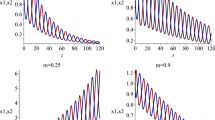Abstract
On an open interval we follow the paths of a Brownian motion which returns to a fixed point as soon as it reaches the boundary and restarts afresh indefinitely. We determine that two paths starting at different points either cannot collapse or they do so almost surely. The problem can be modelled as a spatially inhomogeneous random walk on a group and contrasts sharply with the higher dimensional case in that if two paths may collapse they do so almost surely.
Similar content being viewed by others
REFERENCES
Böhm, W. (2000). The correlated random walk with boundaries: a combinatorial solution. J. Appl. Probab. 37(2), 470–479.
Grigorescu, I., and Kang, M. (2002). Brownian motion on the figure eight. J. Theoret. Probab. 15(sn3), 817–844.
Grigorescu, I., and Kang, M. (2001). Path Collapse for Multidimensional Brownian Motion with Rebirth, preprint.
Karatzas, I., and Shreve, S. (1991). Brownian Motion and Stochastic Calculus, 2nd edn., Springer.
Munkres, James R. (1975). Topology: A First Course, Prentice-Hall, Inc., Englewood Cliffs, N.J.
Author information
Authors and Affiliations
Corresponding author
Rights and permissions
About this article
Cite this article
Grigorescu, I., Kang, M. Path Collapse for an Inhomogeneous Random Walk. Journal of Theoretical Probability 16, 147–159 (2003). https://doi.org/10.1023/A:1022282505543
Issue Date:
DOI: https://doi.org/10.1023/A:1022282505543



